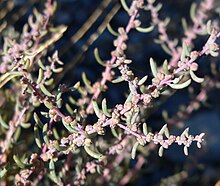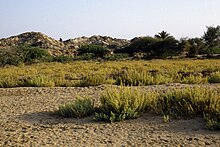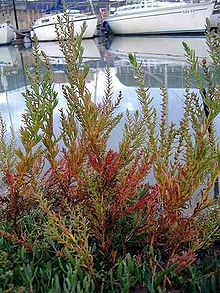
Amaranthaceae is a family of flowering plants commonly known as the amaranth family, in reference to its type genus Amaranthus. It includes the former goosefoot family Chenopodiaceae and contains about 165 genera and 2,040 species, making it the most species-rich lineage within its parent order, Caryophyllales.

C4 carbon fixation or the Hatch–Slack pathway is one of three known photosynthetic processes of carbon fixation in plants. It owes the names to the 1960s discovery by Marshall Davidson Hatch and Charles Roger Slack.

The Salicornioideae are a subfamily of the flowering plant family Amaranthaceae. Important characters are succulent, often articulated stems, strongly reduced leaves, and flowers aggregated in thick, dense spike-shaped thyrses. These halophytic plants are distributed worldwide. Many are edible

The Salsoloideae are a subfamily of the Amaranthaceae, formerly in family Chenopodiaceae.

The Chenopodioideae are a subfamily of the flowering plant family Amaranthaceae in the APG III system, which is largely based on molecular phylogeny, but were included – together with other subfamilies – in the family Chenopodiaceae, or goosefoot family, in the Cronquist system.
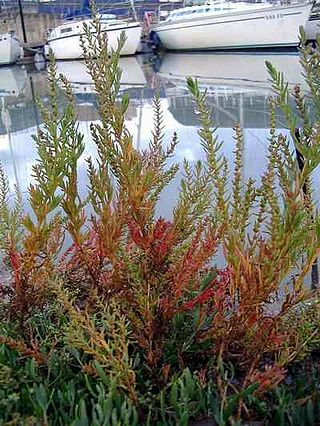
Suaeda is a genus of plants also known as seepweeds and sea-blites. Most species are confined to saline or alkaline soil habitats, such as coastal salt-flats and tidal wetlands. Many species have thick, succulent leaves, a characteristic seen in various plant genera that thrive in salty habitats.

Salsola is a genus of the subfamily Salsoloideae in the family Amaranthaceae. The genus sensu stricto is distributed in Australia, central and southwestern Asia, North Africa, and the Mediterranean. Common names of various members of this genus and related genera are saltwort and tumbleweed or roly-poly. The genus name Salsola is from the Latin salsus, meaning 'salty'.
Suaeda aralocaspica is a species of plant in the family Amaranthaceae that is restricted to the deserts of Central Asia. It is a halophyte and uses C4 carbon fixation but lacks the characteristic leaf anatomy of other C4 plants (known as kranz anatomy). Carrying out complete C4 photosynthesis within individual cells, these plants instead are known as single‐cell C4 system or SCC4 plants. This makes them distinct from typical C4 plants, which require the collaboration of two types of photosynthetic cells. SCC4 plants have features that make them potentially valuable in engineering higher photosynthetic efficiencies in agriculturally important C3 carbon fixation species such as rice. To address this, the 467 Mb genome of S. aralocaspica has been sequenced to help understanding of the evolution of SCC4 photosynthesis and contribute to the engineering of C4 photosynthesis into other economically important crops.

Bassia is a genus of flowering plants in the family Amaranthaceae. They are distributed in the western Mediterranean to eastern Asia. Some occur outside their native ranges as introduced species.

Haloxylon is a genus of shrubs or small trees, belonging to the plant family Amaranthaceae. Haloxylon and its species are known by the common name saxaul. "Saksaul" is a common Turkic word that entered Russian through Kazakh.

The Polycnemoideae are a small subfamily of plants in the family Amaranthaceae, representing a basal evolutionary lineage. The few relictual species are distributed in Eurasia and North Africa, North America, and Australia.
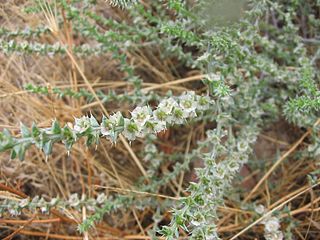
Kali was a genus of plants in the subfamily Salsoloideae in the family Amaranthaceae, that has now been subsumed into the genus Salsola.

Anabasis is a genus of plants in the subfamily Salsoloideae of the family Amaranthaceae. It is distributed in southern Europe, North Africa, and Asia.
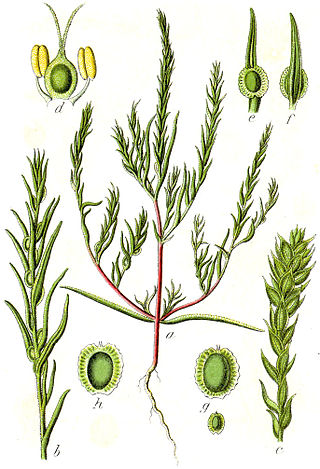
The Corispermoideae are a subfamily of the Amaranthaceae, formerly in family Chenopodiaceae.
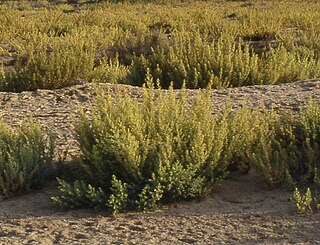
Bienertia sinuspersici is a flowering plant that currently is classified in the family Amaranthaceae, although it was previously considered to belong to the family Chenopodiaceae.

Bienertia is a flowering plant genus that currently is classified in the family Amaranthaceae s.l.. For long time, the genus was considered to consist only of one species, Bienertia cycloptera, but in 2005 and 2012, two new species have been separated.

Bienertia cycloptera is a species of flowering plant that is native to the Middle East, south-eastern Europe, and central Asia. It is a succulent, smooth annual plant with long, curved, cylindrical leaves. Its flowers have both male and female reproducing parts and its fruits are small and spherical. Bienertia cycloptera grows in hot, dry climates with little rainfall and tolerates soils with high salinity levels very well. Due to its specific growing conditions, B. cycloptera is not a very common, nor widespread plant. Even over most of its range, it often grows sparsely in small patches of growth. One notable aspect of Bienertia cycloptera is its unique C4 photosynthesis mechanism. Unlike most C4 plants, in B. cycloptera the photosynthetic mechanism occurs within a single chlorenchyma cell, without Kranz anatomy.
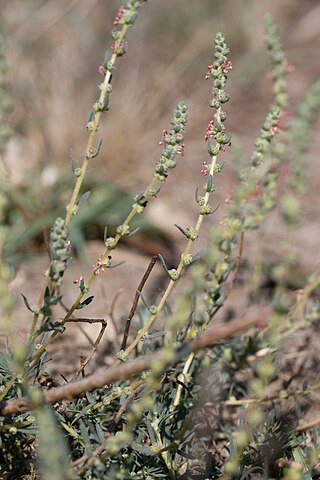
Camphorosma is a genus of flowering plants in the family Amaranthaceae, found in northern Africa, southern and eastern Europe, Crimea, Russia, Anatolia, the Caucasus, Iran, Afghanistan, Pakistan, Central Asia, the Altai, western Siberia, Xinjiang in China, and Mongolia. Annuals or subshrubs, they can be distinguished from closely related taxa such as Bassia by their flattened perianths which have four lobes, inflorescences with multicellular glandular hairs, a distinct C4 leaf anatomy type (called the Camphorosma type), and a chromosome count of 2n = 12.

Hammada is a genus of flowering plants belonging to the family Amaranthaceae. It is also in the Salsoloideae subfamily. Although it is a very unclear and unsorted genus with many species that have later been classed as synonyms.
